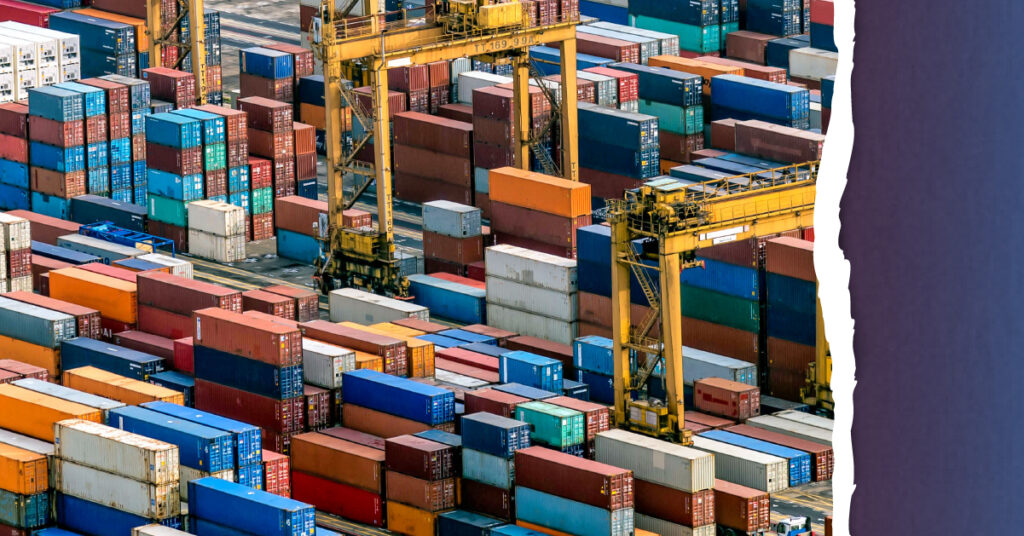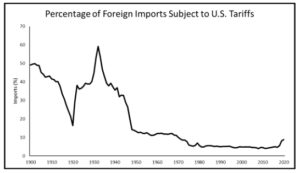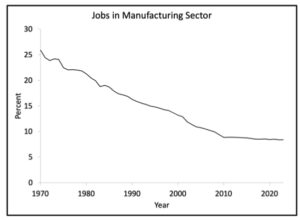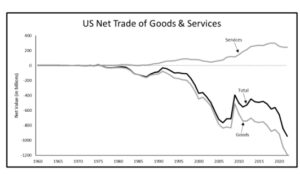A large chunk of America’s economy involves international trade – buying (importing) and selling (exporting) goods and services across national borders. International trade has clear benefits: Americans can purchase a wider range of goods, often cheaper than from domestic producers. Trade also creates new markets for American businesses, allowing them to sell more products, and increasing profits and employment. At the same time, by increasing competition, trade can force American companies out of business and workers out of jobs because of foreign competition. Faced with these benefits and costs, is free trade a good idea – and for whom?
Why Do Nations Trade?
The basis of international trade stems from comparative advantage: each nation concentrates on producing primarily those goods and services where they are the lowest-cost supplier (or leverage some form of unique, technical or related advantage), and import most everything else from other nations. In this way, trade increases efficiency and economic growth.
A nation’s comparative advantage depends on factors such as the skills held by its labor force, infrastructure, and natural resources. For example, while Vietnam has a comparative advantage in manufacturing due to lower labor costs, the United States specializes in service industries. By the logic of comparative advantage, the United States should export services such as management consulting and financial advising, while Vietnam exports textiles, machinery, and computer chips.
The downside of comparative advantage is that domestic industries might be outcompeted due to foreign competition, resulting in unemployment and economic hardship. Following this example, an American retail company might buy clothing from a factory in Vietnam because it costs less than buying the same items from an American clothing factory. (On average, manufacturing labor costs in Vietnam are much lower than in the United States). The American company’s imports keep the Vietnamese factory in business and allow it to sell products at a lower price – but it might put some American clothing factories out of business because they cannot match the cheaper prices of their Vietnamese counterparts. Additionally, in some instances the country importing such products or services could lack control over quality and availability of critical items like prescription medicines.
What Are The Main Options For America’s Trade Policies?
Generally, trade policy involves a choice between free trade and protectionism. A free trade policy encourages individuals and businesses to purchase the cheapest-possible products that serve their needs, regardless of where it is produced. For example, if an American company needed to purchase computer chips, it would buy from the producer with the lowest price, even if the producer was in another country.
Protectionism is the opposite of free trade. It focuses on restricting trade for the purpose of protecting a nation’s industries from foreign competition. Protectionist policies are generally implemented using tariffs. Tariffs are taxes that nations impose on imports to protect domestic industries from foreign competition. The tariff is added to the price of the import and is paid by importers and passed on to consumers. Some tariffs target raw materials, others focus on final products, and they vary in severity as well.
A protectionist strategy is attractive for two reasons. One is national security. For example, the United States might want to ensure that it had domestic sources of computer chips, so that the supply would be secure even in a time of war that disrupted supply chains. Protectionism also secures domestic jobs from foreign competition. That is, an American factory that produced computer chips could stay in business by selling chips to American consumers even if a foreign company could manufacture chips at a lower price because the price of the foreign company’s chips was increased by a tariff.
The downside of tariffs is that they increase the prices that consumers pay for imported goods and services. In addition, if one nation raises its tariffs, other nations may respond with their own tariffs, creating a situation where everyone pays higher prices than they would otherwise and negating the benefits of comparative advantage.
What Is America’s Trade Policy?
Since World War II, the trade policies of the US and other major industrialized democracies have generally moved towards free trade. As shown in the figure below, in 1930, the average US tariff on foreign goods was 60% of the wholesale price, but that number fell to 4% by 1989 and 1.6% by 2011. Some US tariffs have been increased in recent years, but in general, tariffs are much lower than they were two generations ago.
Lowering barriers to trade has increased US imports and exports as shown in the figure below (imports are the black line, exports are the red line). Both imports and exports are shown as a percentage of GDP (Gross Domestic Product, a measure of the size of the US economy). In recent years, imports have been about 15 percent of GDP, while exports are about 11 percent. The difference between imports and exports is the trade deficit (discussed below).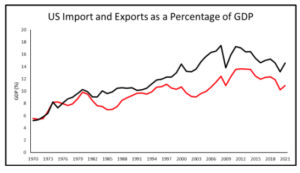
The US is also a key player in building international organizations that regulate trade. The US Founded in 1995, the World Trade Organization (WTO), which is an international oversight organization that works to reduce trade barriers and implement the principle of comparative advantage. One hundred sixty-four nations are members of the WTO, and the organization helps to oversee trade agreements and settle disputes between member states.
What Are The Strengths And Weaknesses Of America’s Current Trade Policy?
The United States’ open economy and its dedication to free trade have significant benefits. Participation in agreements to lower tariffs and eliminate other barriers to trade means that US consumers can regularly buy a wider range of foreign goods at lower prices, raising their purchasing power. Lower tariffs also create new export markets for American corporations.
However, encouraging imports and exports has important disadvantages. The ability to import goods from countries that manufacture them for much cheaper prices poses serious issues for some American companies and their employees. As shown in the figure below, over the last two generations, the percentage of Americans who work in the manufacturing sector has declined from about 25 percent in 1971 to less than 9 percent in 2023.
At the same time, imports of manufactured goods from Mexico, China, and other nations have dramatically increased. These trends highlight the costs and benefits of free trade: while free trade lowers prices for many American consumers and creates new jobs in American industries that build exportable products, it hurts industries that lose business to cheaper foreign suppliers – as well as their employees and the local economies where these industries are located.
Is America Getting Taken Advantage Of In Its Trade With Other Nations?
The main argument for America getting taken advantage of in international trade is the size of the trade deficit – the difference between the value of goods imported and goods exported. The dark line in the figure below shows the value of the US trade deficit in billions of dollars. It shows that the US has consistently run a trade deficit since the early 1980s, amounting to almost a trillion dollars annually by 2020.
If we think of a country as a person, a trade deficit would amount to spending more money than is earned, which would be a problem if the disparity was large enough and continued long enough. At the national level, however, this logic does not always apply. Many economic analyses show that a trade deficit is a sign of economic strength, as well-off consumers spend more money to import goods from other nations, and foreigners invest money in well-run American businesses. And it is important to remember that despite running a sizable trade deficit for the last 40 years, America has had low unemployment, low inflation, and consistent economic growth for most of this time.
Another way of looking at America’s trade deficit is to separate trade in goods from trade in services, as shown in the two gray lines in the above figure. As the figure shows, while the US has an increasing trade deficit in goods, it also has an increasing trade surplus in services. Here again, the data suggests the value of free trade to the US, as American individuals and businesses import low-profit margin goods from other countries and export high-profit margin services to these same nations.
The other “taking advantage” issue from free trade is the consequences of this policy for the workers who lose wages and jobs because consumers switch to cheaper imports. There is no doubt that free trade makes these workers and their communities worse off, at least in the short run. Thus, trade policy is an example of a situation where even if a policy choice (free trade, protectionism, or some combination) may make a nation as a whole better off, there will be some winners and some losers in specific industries or communities.
Further Reading
Irwin, D. A. (2020). Trade policy in American economic history. Annual Review of Economics, 12, 23-44.
Akhtar, S. I., Cimino-isaacs, C. D., & Sutter, K. M. (2023) U.S. Trade Policy: Background and Current Issues. Congressional Research Service, available at https://tinyurl.com/5n8pxsy6.
U.S. Mission Geneva. (2022, December 14). 15th trade policy review of the United States. U.S. Mission to International Organizations in Geneva, available at https://tinyurl.com/3427tn5f, accessed 4/25/23.
Sources
Why Do Nations Trade?
de la Calle, L. (2016). Mexico’s Strategic Comparative Advantage in International Trade: At the Crossroads of NAFTA, the Pacific Alliance, TPP, and TTIP. German Marshall Fund of the United States. http://www.jstor.org/stable/resrep18791
Mcdonald, B., International Trade: Commerce Among Nations. International Monetary Fund, accessed 4/9/23. Available at https://tinyurl.com/yc7x5f76.
America’s Current Trade Policy
Irwin, D. A. (2020). Trade policy in American economic history. Annual Review of Economics, 12, 23-44.
Amiti, M., Redding, S. J., & Weinstein, D. E. (2019). The Impact of the 2018 Tariffs on Prices and Welfare. The Journal of Economic Perspectives, 33(4), 187–210. https://www.jstor.org/stable/26796842
Pagán, M. L. 2022. 15th Trade Policy Review of the United States accessed on 4/20/23. Available at https://tinyurl.com/mtdyxwtf (Imports and Exports Chart)
World Bank. (2023) Tariff Rates. https://tinyurl.com/zedpcc72, accessed 4/15/23 (Tariff Levels Chart)
World Trade Organization. (2023) What is the WTO? World Trade Organization, accessed 4/14/23. Available at https://tinyurl.com/5cs4wsed.
Strengths and Weaknesses of Current Trade Policy
Akhtar, S. I., Cimino-isaacs, C. D., & Sutter, K. M. (2023). U.S. Trade Policy: Background and Current Issues. Congressional Research Service. https://tinyurl.com/5n8pxsy6 , accessed 4/25/23
U.S. Mission Geneva. (2022, December 14). 15th trade policy review of the United States. U.S. Mission to International Organizations in Geneva, available at https://tinyurl.com/3427tn5f, accessed 4/25/23.
Romalis, J. 2007. NAFTA’s and CUSFTA’s Impact on International Trade. The Review of Economics and Statistics 2007; 89 (3): 416–435. doi: https://doi.org/10.1162/rest.89.3.416
FRED (2023). All Employees, Total Nonfarm, Federal Reserve Bank of St. Louis, https://fred.stlouisfed.org/series/PAYEMS, accessed 6/20/23 (Chart Data)
FRED (2023). All Employees, Manufacturing, Federal Reserve Bank of St. Louis, https://fred.stlouisfed.org/series/MANEMP, accessed 6/20/23 (Chart Data)
Is the US Being Taken Advantage Of?
Schwarzenberg, A. (2020) The US Trade Deficit: An Overview, Congressional Research Service, https://tinyurl.com/5ea9vvuv , accessed 6/20/23
Ossa, R. (2014). Trade Wars and Trade Talks with Data. The American Economic Review, 104(12), 4104–4146. http://www.jstor.org/stable/43495366.
McBride, J. and A. Chatzky (2019) The U.S. Trade Deficit: How Much Does It Matter? Council on Foreign Relations, https://tinyurl.com/4t3s755b, accessed 6/20/23
Bureau of Economic Analysis (2023). International Trade in Goods and Services, https://tinyurl.com/cxk95j27, accessed 6/20/23 (Chart Data)
This policy brief was researched and written in March/April 2023 by Policy vs. Politics interns Sarah Hannah, Jordyn Ives, and Aditi Menon, and revised by Dr. Nicholas Clark and Dr. William Bianco, both members of the Policy vs. Politics Research Team

